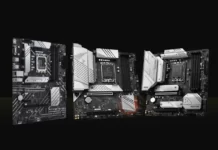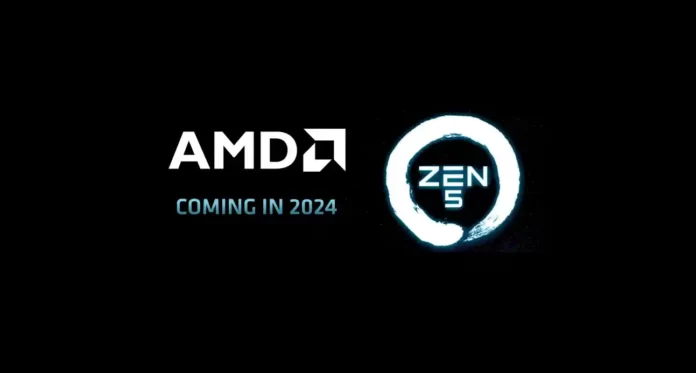The first performance, frequency, and power projections for the upcoming Zen 5 architecture, which is anticipated to debut next year, have been made public by Jim Keller, who collaborated with AMD on designing several Zen CPU architectures.
Next-Gen Zen 5 Architecture Performance, Power, and CPU Frequency Estimates from AMD’s Former Chip Architect, Jim Keller
Jim Keller, the acting CEO of Tenstorrent, announced an event at an Indian university. He also discussed how their next-generation RISC-V architecture, which will be used in the forthcoming Ascalaon chips, is progressing. The next-generation Zen 5 CPU IP for the next-generation Ryzen & EPYC chips was shared by Jim throughout the keynote, along with some other both internal and external architecture performance predictions.
As we begin with the performance details, it’s important to remember that they are only predictions and that the result may change significantly. Jim reports that Tenstorrent predicts AMD’s Zen 5 core architecture will be roughly 30% faster than Zen 4. This represents a significant improvement over Zen 3 cores, as the Zen 4 architecture demonstrates. Zen 2 was a 6% improvement over Zen 1, while Zen 3 was a massive 30% improvement over Zen 2.
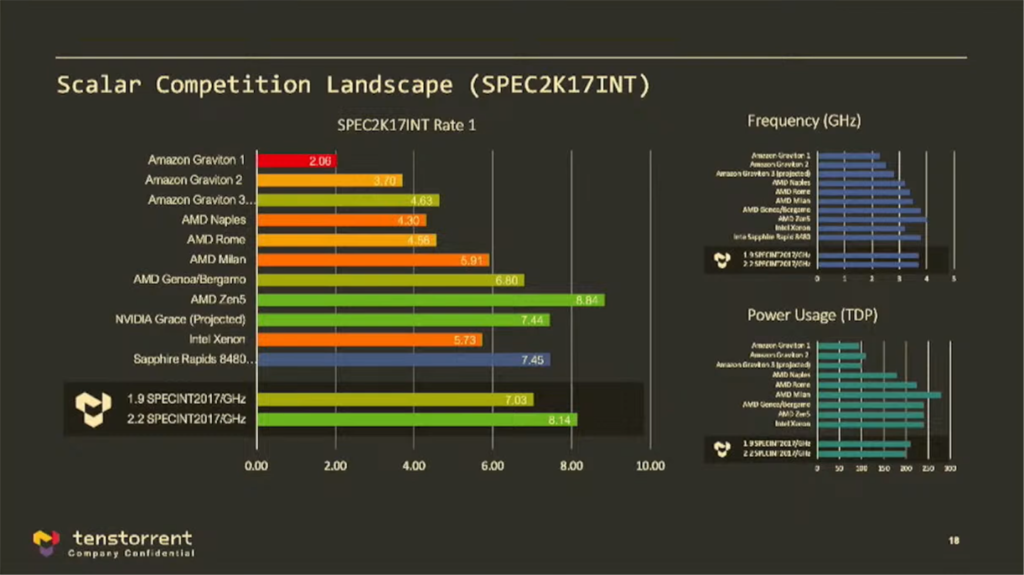
Each performance prediction relies on the SPEC2K17 INT workload, which might not be an appropriate measure for workloads encountered in the real world but is a metric frequently employed in assessing performance in the server ecosystem. The AMD Zen 5 is expected to outperform competing chips by 18 to 20%, including the NVIDIA Grace and Intel Xeon Sapphire Rapids.
The complete list of results is given below; keep in mind that these are all server-level products, not the ones that each vendor would sell to consumers:
Tenstorrent Scalar Competition Landscape (SPEC2K17 INT Rate 1 Performance Estimates):
| CPU LINEUP | ARCHITECTURE | SPEC RATE 1 | RELATIVE PERF |
|---|---|---|---|
| AMD Naples | Zen 1 | 4.30 | 100% |
| AMD Rome | Zen 2 | 4.56 | 106% |
| AMD Milan | Zen 3 | 5.91 | 137% |
| AMD Genoa | Zen 4 | 6.80 | 158% |
| AMD Turin | Zen 5 | 8.84 | 205% |
Tenstorrent anticipates AMD Zen 5 CPUs to be the first to approach or surpass the 4 GHz mark on the server platform, which makes the performance and charts of frequencies equally fascinating. It appears that Zen 5 will be the first to achieve this goal unless Intel can step it up with Emerald Rapids, which will be released later this year. With respective boost clocks of 3.70 and 3.80 GHz, the EPYC Genoa and Intel Sapphire Rapids families come close to this target. Still, it appears that Zen 5 will be the first to achieve it, barring an improvement from Intel with Emerald Rapids, which will be released later this year.
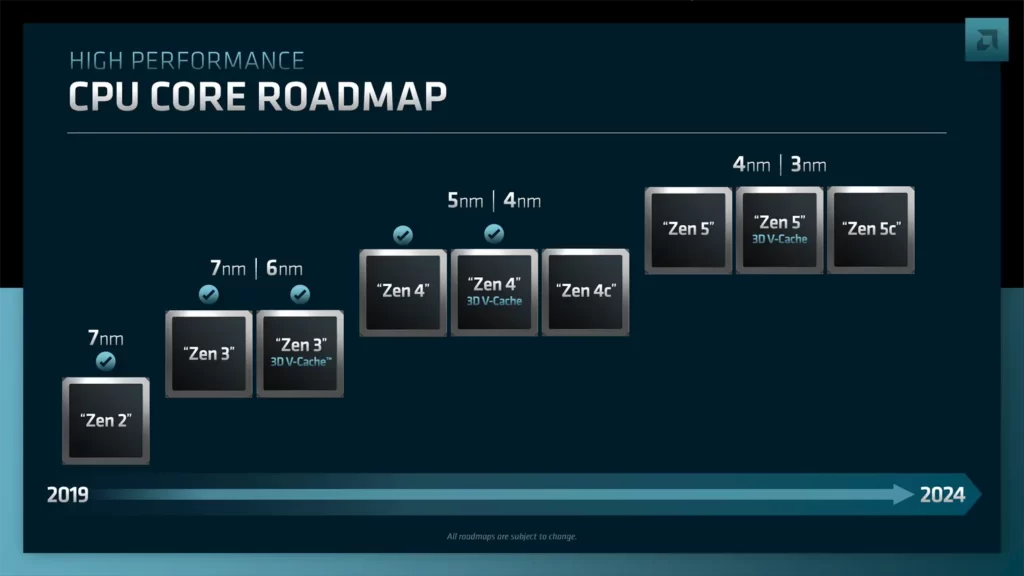
The estimated power metrics won’t change, but the 30% improvement in output that we mentioned above will result in even greater efficiency because of a 4nm/3nm process node.
AMD Zen 5 in 2024 Will Include New Microarchitecture V-Cache & Compute Variants-
AMD has officially announced the expected debut of the new Zen 5 architecture in 2024. The processing unit was built from the ground up with a new microarchitecture focused on offering improved speed and effectiveness, a re-pipelined front-end, and the broad gap in addition to Integrated AI and machine learning optimization. The first generation of Zen 5 CPUs will be available in three flavors (Zen 5 / Zen 5 V-Cache / Zen 5C). Key characteristics of Zen 5 CPUs include:
- Improved effectiveness and efficiency
- Wide issue and new front-end pipeline
- AI and machine learning optimizations are integrated.
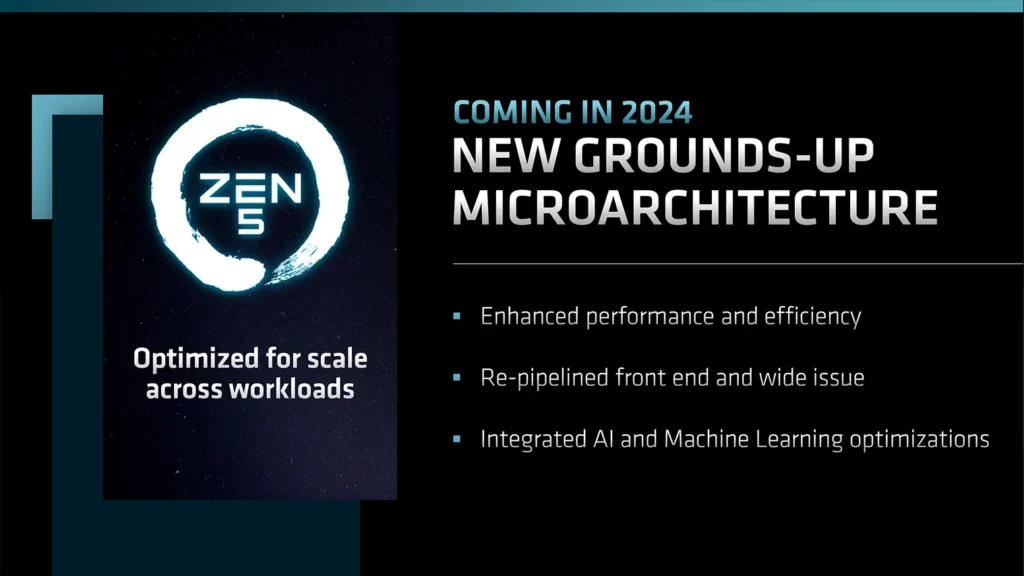
Therefore, if we experience a similar increase in performance to what we did with Zen 3, users of Ryzen’s consumer-level processors will find it extremely significant. However, multi-threaded efficiency might be even better as this particular performance metric only considers single-threaded prowess. Once more, it’s important to remember that these are only estimates. Still, AMD has repeatedly shown that it can outperform initial projections by a sizable margin. Since Zen 5 is an entirely new architecture created from the bottom up, one ought to be more than optimistic.
AMD EPYC CPU Families:
| FAMILY NAME | AMD EPYC VENICE | AMD EPYC TURIN | AMD EPYC SIENA | AMD EPYC BERGAMO | AMD EPYC GENOA-X | AMD EPYC GENOA | AMD EPYC MILAN-X | AMD EPYC MILAN | AMD EPYC ROME | AMD EPYC NAPLES |
|---|---|---|---|---|---|---|---|---|---|---|
| Family Branding | EPYC 11K? | EPYC 10K? | EPYC 9000? | EPYC 9000? | EPYC 9004 | EPYC 9004 | EPYC 7004 | EPYC 7003 | EPYC 7002 | EPYC 7001 |
| Family Launch | 2025+ | 2024 | 2023 | 2023 | 2023 | 2022 | 2022 | 2021 | 2019 | 2017 |
| CPU Architecture | Zen 6? | Zen 5 | Zen 4 | Zen 4C | Zen 4 V-Cache | Zen 4 | Zen 3 | Zen 3 | Zen 2 | Zen 1 |
| Process Node | TBD | 3nm TSMC? | 5nm TSMC | 4nm TSMC | 5nm TSMC | 5nm TSMC | 7nm TSMC | 7nm TSMC | 7nm TSMC | 14nm GloFo |
| Platform Name | TBD | SP5 / SP6 | SP6 | SP5 | SP5 | SP5 | SP3 | SP3 | SP3 | SP3 |
| Socket | TBD | LGA 6096 (SP5) LGA XXXX (SP6) | LGA 4844 | LGA 6096 | LGA 6096 | LGA 6096 | LGA 4094 | LGA 4094 | LGA 4094 | LGA 4094 |
| Max Core Count | 384? | 128? | 64 | 128 | 96 | 96 | 64 | 64 | 64 | 32 |
| Max Thread Count | 768? | 256? | 128 | 256 | 192 | 192 | 128 | 128 | 128 | 64 |
| Max L3 Cache | TBD | TBD | 256 MB? | TBD | 1152 MB | 384 MB | 768 MB | 256 MB | 256 MB | 64 MB |
| Chiplet Design | TBD | TBD | 8 CCD’s (1CCX per CCD) + 1 IOD | 12 CCD’s (1 CCX per CCD) + 1 IOD | 12 CCD’s (1 CCX per CCD) + 1 IOD | 12 CCD’s (1 CCX per CCD) + 1 IOD | 8 CCD’s with 3D V-Cache (1 CCX per CCD) + 1 IOD | 8 CCD’s (1 CCX per CCD) + 1 IOD | 8 CCD’s (2 CCX’s per CCD) + 1 IOD | 4 CCD’s (2 CCX’s per CCD) |
| Memory Support | TBD | DDR5-6000? | DDR5-5200 | DDR5-5600? | DDR5-4800 | DDR5-4800 | DDR4-3200 | DDR4-3200 | DDR4-3200 | DDR4-2666 |
| Memory Channels | TBD | 12 Channel (SP5) 6-Channel (SP6) | 6-Channel | 12 Channel | 12 Channel | 12 Channel | 8 Channel | 8 Channel | 8 Channel | 8 Channel |
| PCIe Gen Support | TBD | TBD | 96 Gen 5 | 160 Gen 5 | 128 Gen 5 | 128 Gen 5 | 128 Gen 4 | 128 Gen 4 | 128 Gen 4 | 64 Gen 3 |
| TDP (Max) | TBD | 480W (cTDP 600W) | 70-225W | 320W (cTDP 400W) | 400W | 400W | 280W | 280W | 280W | 200W |
News source: wccftech.com























